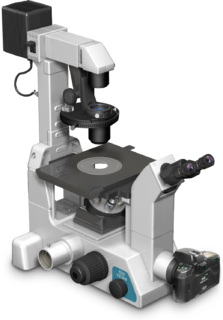Nikon’s Museum of Microscopy
Eclipse TE300 Inverted Microscope
( 1997 )
The advent of the infinity-corrected CFI60 optical system spurred Nikon design engineers to upgrade their research-caliber inverted microscope from the Diaphot 300 to the Eclipse TE300 in 1997. The vastly improved instrument provides longer working distances that accommodate a wide variety of culture vessels and thick specimens, while maintaining high numerical apertures to ensure suitable levels of brightness, imaging contrast, resolution, and sharpness.

The paired oculars of the instrument provide a standard 22-millimeter field of view, but like other microscopes in the Eclipse line, the Nikon TE300 is highly modular and provides several options for binocular and trinocular tubes, condensers, stages, and illumination systems. The standard condenser system fabricated for the Nikon TE300 microscope consists of a series of condenser top lenses and a five-position turret assembly with components for phase, differential interference, and Hoffman modulation contrast techniques. Also, Nikon designers patented a video enhancement contrast system for the microscope that features special polarizers and analyzers that enable the visualization of low contrast minutiae that would ordinarily go unnoticed by traditional video imaging methods.
The multi-port design of the TE300 accommodates a variety of devices and its four-way light distribution system ensures adequate light allocation. In the illustration above, a 35mm Nikon SLR camera is attached to the front port of the instrument. The side-port in the base of the stand is shown vacant, but it can accommodate either a high-performance digital camera or the now-obsolete Nikon FX-III photomicrographic system. A thin relay lens between the side port and the microscope base enables the detection of images without sacrificing brightness or resolution. However, since many fluorescent images produce extremely faint rays of light, Nikon offers an optional 0.8x relay lens that increases brightness by a factor of 1.5 and, therefore, increases the signal gathered by imaging devices. A special model of the TE300, which is best suited for laser work, features a bottom port for high quality video images that directly feed from the objectives.
The most current successor to the Eclipse TE300 is the Nikon Eclipse Ti2 inverted microscope.













